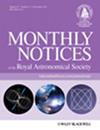Modeling the day-night temperature variations of ultra-hot Jupiters: confronting non-grey general circulation models and observations
IF 4.8
3区 物理与天体物理
Q1 ASTRONOMY & ASTROPHYSICS
引用次数: 0
Abstract
Ultra-hot Jupiters (UHJs) are natural laboratories to study extreme physics in planetary atmospheres and their rich observational data sets are yet to be confronted with models with varying complexities at a population level. In this work, we update the general circulation model of Tan & Komacek (2019) to include a non-grey radiative transfer scheme and apply it to simulate the realistic thermal structures, phase-dependent spectra, and wavelength-dependent phase curves of UHJs. We performed grids of models over a large range of equilibrium temperatures and rotation periods for varying assumptions, showing that the fractional day-night brightness temperature differences remain almost constant or slightly increase with increasing equilibrium temperature from the visible to mid-infrared wavelengths. This differs from previous work primarily due to the increasing planetary rotation rate with increasing equilibrium temperature for fixed host star type. Radiative effects of varying atmospheric compositions become more significant in dayside brightness temperature in longer wavelengths. Data-model comparisons of dayside brightness temperatures and phase curve amplitudes as a function of equilibrium temperature are in broad agreement. Observations show a large scatter compared to models even with a range of different assumptions, indicating significantly varying intrinsic properties in the hot Jupiter population. Our cloud-free models generally struggle to match all observations for individual targets with a single set of parameter choices, indicating the need for extra processes for understanding the heat transport of UHJs.超热木星昼夜温度变化建模:面对非灰色大气环流模型和观测结果
超热木星(UHJs)是研究行星大气中极端物理学的天然实验室,其丰富的观测数据集还有待于在群体水平上用不同复杂程度的模型来面对。在这项工作中,我们更新了 Tan & Komacek(2019)的大气环流模型,加入了非灰色辐射传递方案,并将其用于模拟 UHJs 的现实热结构、相位相关光谱和波长相关相位曲线。我们在很大的平衡温度和旋转周期范围内对不同假设条件下的模型进行了网格计算,结果表明,从可见光到中红外波段,随着平衡温度的升高,昼夜亮度温差分数几乎保持不变或略有增加。这与以往的研究不同,主要是因为在固定的主星类型下,随着平衡温度的升高,行星自转速率也在增加。在较长的波长中,不同大气成分的辐射效应对日侧亮度温度的影响更加显著。作为平衡温度函数的日侧亮度温度和相位曲线振幅的数据与模型比较结果基本一致。即使在一系列不同的假设条件下,观测结果与模型相比也有很大的差异,这表明热木星群的内在性质有很大的不同。我们的无云模型通常很难在选择一组参数的情况下与单个目标的所有观测结果相匹配,这表明需要额外的过程来理解超高质量木星的热传输。
本文章由计算机程序翻译,如有差异,请以英文原文为准。
求助全文
约1分钟内获得全文
求助全文
来源期刊

Monthly Notices of the Royal Astronomical Society
ASTRONOMY & ASTROPHYSICS-
CiteScore
9.10
自引率
37.50%
发文量
3198
审稿时长
3 months
期刊介绍:
Monthly Notices of the Royal Astronomical Society is one of the world''s leading primary research journals in astronomy and astrophysics, as well as one of the longest established. It publishes the results of original research in positional and dynamical astronomy, astrophysics, radio astronomy, cosmology, space research and the design of astronomical instruments.
 求助内容:
求助内容: 应助结果提醒方式:
应助结果提醒方式:


